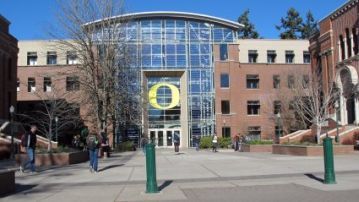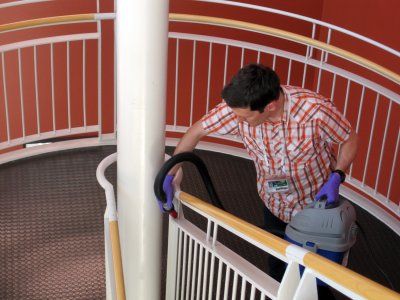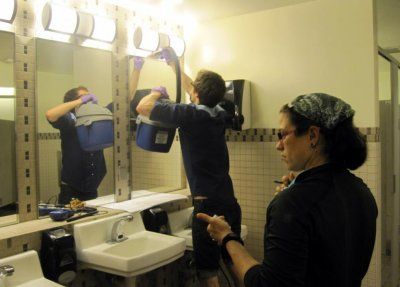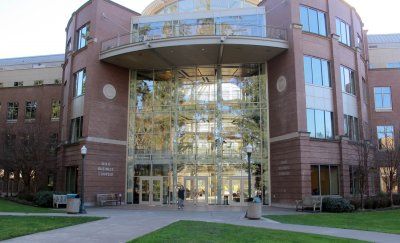
Publisher:
Bonnie King
CONTACT:
Newsroom@Salem-news.com
Advertising:
Adsales@Salem-news.com

~Truth~
~Justice~
~Peace~
TJP
Jan-29-2014 20:41

 TweetFollow @OregonNews
TweetFollow @OregonNews
Oregon Researchers Show how Building Design Impacts Indoor Bacteria
Salem-News.comResearch center aims to understand the 'indoor microbiome' and improve it through architectural design
 Special thanks to Jim Barlow, University of Oregon |
(EUGENE) - The Lillis Business Complex set the bar for sustainable buildings 10 years ago when it opened at the University of Oregon. Now microbes drawn from the dust in 155 of its rooms have provided clues that could inspire future architectural designers to encourage a healthy indoor environment.
Researchers used specially filtered vacuum cleaners to collect dust in offices, classrooms, hallways, bathrooms and storage closets to develop a microbial snapshot of the building, based on where people congregated, how people used indoor spaces, and how these spaces were connected to allow human movement between them.
 Study co-author Steve Kemel collects |
Reporting in the Jan. 29 issue of PLOS ONE, a publication of the non-profit Public Library of Science, a 10-member team of biologists and architects noted that Proteobacteria, Fermicutes and Deinococci dominate the building, but these communities vary with architectural choices. The researchers concluded that their findings "give clear evidence that design choices can influence the biogeography of microbial communities indoors."
The study is part of the UO's Biology and the Built Environment (BioBE) Center's quest to explore the microbiome of the indoor world, where people spend the majority of their time. Microbiome refers to the total makeup of microorganisms and their collective genetic material found in or on the human body or in another environment.
 James Meadow |
The team analyzed DNA from more than 30,000 different types of bacteria throughout the Complex. "We found that what you do in a room, how many people there are in a room and how many different people are in a room all make a big difference," said James Meadow a postdoctoral research associate in the BioBE center. "Even an office with one person year round versus a classroom with hundreds of people throughout the year will have different kinds of bacteria."
The samples were collected from the complex's centerpiece, Lillis Hall — an airy, 136,000-square-foot facility, which has mechanical air ventilation throughout most of the building, except for a wing of offices where occupants wanted window ventilation. Lillis Hall was the first building in the Eugene-Springfield area to achieve LEED silver certification for its sustainability features. The building was chosen for the study because of its variety of different uses and its flexible operation. For example, Lillis Hall was designed to accommodate both mechanical and natural air ventilation, allowing researchers to observe whether ventilation influences indoor bacterial communities.
Most of the bacteria that were found came as no surprise, Meadow said. "These are found about everywhere we look, inside or outside, and we found some of the same types of bacteria that you would expect to find living in soil and on plants. That tells us that some of the bacteria in buildings are likely being brought in with occupants and with outdoor air — but not equally in all rooms."

For instance, the researchers found that soil- and plant-associated bacteria were most common in unoccupied spaces, such as mechanical rooms and storage closets.
Several different human-gut-associated bacteria, including Lactobacillus, Staphylococcus and Clostridium, were most common in bathroom dust. The researchers found that bathrooms accumulate the most distinctive bacterial communities, likely because of their unique function. They did not screen for disease-causing forms of bacteria.
Deinococcus, whose members are known for their resilience when exposed to radiation and dry conditions, were the "oddballs" in the mix, Meadow said. "They are super tough and can hang out in harsh conditions, and buildings present some harsh conditions. But they were some of the most common bacteria in the building. They were found in all rooms, but more abundant in mechanically ventilated — versus naturally ventilated — rooms. That might suggest that they are accumulating over time while other bacteria dry out and die in buildings."
 |
Naturally ventilated rooms, on the other hand, were associated with more plant- and soil-associated bacteria, like Methylobacterium. "A simple choice of where your air comes from in a building can influence the types of bacteria that you encounter," Meadow said.
"This is a relatively new research area," he said. "We don't really have a list of bacteria that we know that we should come into contact with — such as the Top 20 good bugs or the Top 20 bad bugs, except for maybe a few pathogens. At some point, we will, and this research helps us understand how architecture and occupant behavior can contribute to a healthier indoor microbiome."
About the University of Oregon
The University of Oregon is among the 108 institutions chosen from 4,633 U.S. universities for top-tier designation of "Very High Research Activity" in the 2010 Carnegie Classification of Institutions of Higher Education. The UO also is one of two Pacific Northwest members of the Association of American Universities.
 |
 |
 |
Articles for January 28, 2014 | Articles for January 29, 2014 | Articles for January 30, 2014



googlec507860f6901db00.html
Salem-News.com:

Terms of Service | Privacy Policy
All comments and messages are approved by people and self promotional links or unacceptable comments are denied.
[Return to Top]
©2025 Salem-News.com. All opinions expressed in this article are those of the author and do not necessarily reflect those of Salem-News.com.